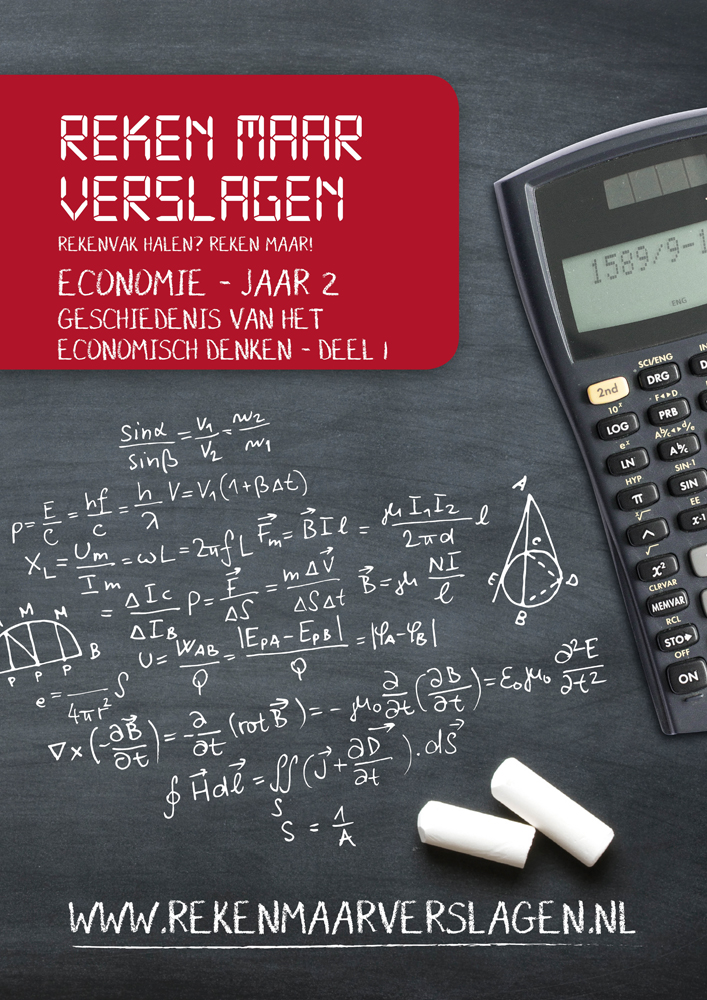No products in the basket.
< All topics
Summary History of Economic Thought Erasmus
Posted on
Last updated on
Summary History of economic thought for the study of Economics and Business Economics at Erasmus University Rotterdam EUR needed? This will make the exam a breeze!
"History of economic thought. Is there any more boring subject at all than this. I really don't feel like doing this at all."

Do you recognise yourself in the sentence above? Then we at Reken Maar Verslagen have the solution for you.
The subject History of Economic Thought FEB12006 is one of the most difficult subjects in the Bachelor of Economics and Business Economics at Erasmus University Rotterdam EUR, you may have already experienced this yourself. Topics like the invisible hand, the laissez-faire principle, Marxism and Social choice theory are generally perceived as very difficult by students. Do you want to start working on these right away so that you complete your history of economic thought exam at Erasmus University with a good grade? With a summary for the subject History of Economic Thought at Erasmus University Rotterdam (EUR), you will simply pass! Read on below to find out what to expect: we will give you some inside info.
Would you like to get started with this right now to complete your history of economic thought exam at Erasmus University with a good grade? Then click here To order your summary history of economic thought!
Want to know even more about history of economic thought or get a brief introduction to the topics within the subject? Then read on below to see what's in store for you.
Summary history of economic thought Erasmus University Rotterdam: basic concepts
History of Economic Thought teaches us to understand why economists today think the way they do today. It describes how theories and ways of thinking have developed over time. This makes it important to know the characteristics of certain movements and to tell the movements themselves apart.
In the history of economic thought summaries, which you here can order, these currents will be explained in the same order as in the lectures. Furthermore, there will also be a mash-up page for each stream that you can use to learn everything without spending a lot of time. Many of the topics will be familiar from courses such as marco- either microeconomics since these issues stem from old ideas.
In this article, we are going to go through the following basic concepts with you. If you know these, you already know a little bit about what to expect for the history of economic thought exam:
- Key concept 1: Adam Smith
- Key concept 2: Laissez-faire
- Key concept 3: Marxism
- Key concept 4: Social choice theory
- Key concept 5: Chicago School
Summary History of economic thought Erasmus Rotterdam - Key concept 1: Adam Smith
Adam Smith is one of the first classical economists discussed in the summary history of economic thought Erasmus Rotterdam. He has two important works that form the basis for many future ideas within economics, namely the Theory of Moral Sentiments and The Wealth of Nations.
In his Theory of Moral Sentiments he mainly described that he felt individuals should keep their selfishness in check to work together and create a liveable society.
Next, his work The Wealth of Nations. This one has been of greater influence and so will be discussed in more detail. It consists of five books:
1. Price theory.
2. Capital change and financial systems.
3. History (development of agriculture in Europe).
4. International trade (critique of mercantilism).
5. Role of the public sector.
The first book, price theory, deals, among other things, with a paradox within the theory of value. Normally you would think that, for example, materials that have greater utility and are therefore more valuable to mankind would be more expensive, but this is not always the case. Adam Smith names the example of the water diamonds paradox. Namely, water is very useful, so it has a high value of utility, but is very cheap. Diamonds are actually not that useful, but are very expensive. So there is a paradox between value of utility and value in trade.
Would you like to know more about the continuation of the first book, or the contents of the other books? Then order your own summary history of economic thought Erasmus Rotterdam now here!
Summary History of economic thought Erasmus Rotterdam - Key concept 2: Laissez-faire
Laissez-faire is a concept within economics coined by Frenchman Quesnay. This concept, published in his work Tableau Economique (1759), actually means nothing more than free trade. Quesnay believed that agriculture was the basis for economic prosperity, , unlike the Mercantilists that exports were. Since agriculture was the basis of the economy, Quesnay believed the government should promote free competition and trade to create more wealth.
Adam Smith adopted these ideas in his work The Wealth of Nations in his fourth book. In this book, he describes his beliefs about international trade through the invisible hand and criticises the ideas within Mercantilism.
Quesney's ideas had an effect not only on the work of Adam Smith, but also of later economists. He is the most important economist within the movement of physiocracy. This current instilled some ideas that have remained intact within economics. For instance, economics was first seen as a social science and for the first time seriously considered the flows of goods and money in the economy. Physiocrats also investigated for the first time the effect of shifting taxes and were at the forefront of the discussion on The government's influence on the economy.
You can find out more about the physiocrats and Quesney and how they influenced the contemporary economy in this Summary history of economic thought Erasmus Rotterdam.
Summary History of economic thought Erasmus Rotterdam - Key concept 3: Marxism
Marxism is a socialist movement under its founder Karl Marx. Karl Marx published two major works in which, among other things, he dealt with why capitalism would eventually lead to socialism. He believed that capitalism would cause increasing unemployment and poverty among workers. These would at some point stop taking this and bring about a revolution. The size of the working class will make them prevail and bring about a dictatorship of the proletariat.
Under the socialism private ownership is allowed, but capital and land are owned by the state. Production is planned without profit motive and free markets.
The communism goes a step further. Under communism, everything would be owned by the government and then everything is distributed equally.
Marx detailed in his works how and through which theories socialism would come about, starting with the labour theory of value. Curious about the road to socialism? Then order your summary History of Economic Thought Erasmus Rotterdam now here!
Summary History of economic thought Erasmus Rotterdam - Key concept 4: Social choice theory
We find the basis of social choice theory in Arrow's impossibility theory. According to Arrow, public preferences obtained through voting are not always rational. Thus, the government cannot rely on these public preferences, making public policy meaningless. This is because the will of the people cannot be determined.
Amartya Sen is an influential welfare economist who improved this social choice theory with some additions:
1. Preference intensity.
2. Interpersonal comparisons
With these additions, Sen rejected Arrow's impossibility theory, as the modifications would make it possible for the government to map preferences. Want to know more about these changes to social choice theory? Then order now here the summary history of economic thought Erasmus Rotterdam!
Summary History of economic thought Erasmus Rotterdam - Key concept 5: Chicago School
You can't really label the Chicago School as a movement, but its ideas have the overarching characteristic of coming from the University of Chicago. This school is also called the new classical school called, because of their views on government intervention. Like Smith they believed in the principle of laissez faire and were thus at government intervention. Economists belonging to this "current" are Friendman, Deaton, Becker and Heckman.
The main ideas of the Chicago school can be summarised in five points:
- Optimising behaviour of individuals;
- Prices and wages are equal to long-term competitive equilibrium prices;
- Mathematical focus;
- Rejecting Keynesian thinking;
- Limited role for government.
For the exam, it is important to know all the ideas within the Chicago school and also who they came from. For this, the stem page in this summary history of economic thought Erasmus Rotterdam ideal. All the ideas are clearly explained in it and nicely listed so you can learn them easily.
Summary History of economic thought Erasmus Rotterdam: Exam structure
The final grade for history of economic thought consists of an assignment for 20% and 80% of the final exam. The final exam is a written test with open questions. The open questions can be on any of the required literature and lecture material. It is important that you can recognise, remember and explain all the currents and ideas. Here, it is also extremely important that you know the names of the economists and what ideas go with which names.
Currents and topics that may appear in your exam include:
- Pre-Classical School
- The Classical School
- Marxism
- Marginalist School
- Neoclassical School
- Prosperity Economy
- Keynesian School
- Economic growth and development
- Chicago School
- Development of Econometrics
Summary history of economic thought Erasmus Rotterdam, everything you need to succeed
As you have read, the history of economics subject is really a stomping ground where you have to memorise a lot. This can be very tedious to do, but it is not impossible.
To make mashing easier, the summary of Reken Maar offers you a helping hand in this. The topics mentioned above and all other topics in the subject are discussed and explained in more detail using examples and practice exercises. Furthermore, there will also be cramming pages to help you learn for the test. Order your summaries here. On behalf of the whole of Reken Maar, we wish you good luck in preparing and taking the exam!
Do you find history of economic thought interesting? What can you become with it?
This subject mainly provides a background so that you can properly understand ideas within economics that are derived from old ideas. If you find this subject interesting, in all likelihood you will find economics as a whole very interesting. To get involved with different ideas in economics, a job at university would be ideal. This way, you can do research on this yourself and perhaps also teach students in this field. Furthermore, a job in politics or at the ECB or another bank would suit you well. In these cases, you need to know the consequences of certain policies, something you learn within this profession.
